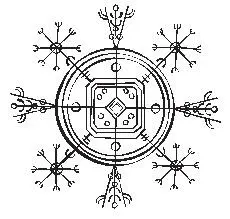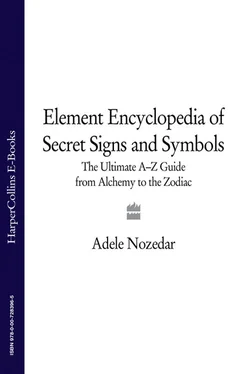The purposes of the symbols tell the story of the lifestyles and concerns of the people down the passage of the years; the importance of a good catch for fishermen, protection against thieves and ghosts, how to frighten away enemies.
The intentions of these ancient symbols are extremely varied and there seems to be one for almost every conceivable occasion. The lists read a little bit like a magical book of household management. There are staves included to help ensure the quality of butter, for lock breaking, and even for raising the dead.
Popularly referred to as Magical Staves, these signs are sometimes comprised of several runic symbols merged together (a bind rune), while others stand alone.

One of these stave symbols is called the Helm of Awe or Aegishjalmur. It looks like a snowflake, except it has eight arms radiating from the central point instead of six.
Its purpose, as the name suggests, was to instill fear in the hearts of enemies and to guard the wearer against abuse of his own power. To work properly it needs to be engraved onto lead and then pressed into the forehead.
Latterly, followers of the Asatru belief adopted the Helm of Awe as one of their cornerstone symbols.
HULINHJALMUR: TO MAKE YOURSELF INVISIBLE

Although invisibility is likely to be an incredibly useful asset, the construction of this stave is particularly tricky. It might not seem too difficult to engrave it on a piece of lignite using magnetic steel that has been hardened by soaking in human blood, but the instructions for blending of the ink could be a real nuisance. The recipe calls for three drops of blood from the index finger of the left hand, and three from the ring finger of the right hand; two drops of blood from the right nipple and one from the left. To this is added six drops of blood from the heart of a living raven. All this blood needs to be melted down with the raven’s brain and parts of a human stomach. Voilà. Now you see me…
Hulinhjalmur, it will be noted, has no counter stave to restore visibility. Neither the author nor the publishers of this book accept any responsibility for misuse of rune staves.
At first glance, this looks like a simple six-spoked wheel. However, the name of Christ is cleverly hidden within it, and like the vesica piscis, was a way for early, persecuted Christians to recognize one another. The Greek letters I X O Y E can be laid over the circle.

These initials form a symbolic monogram for Christ. The monogram comprises the letters iota , ete , and sigma , which are the first three letters of the name of Jesus in Greek, Iesous. The letters also stand for the Latin phrase, Iesous Hominum Salvator , meaning Jesus, Saviour of Man.
Later, the symbol became a sign of peace.
The IHS symbol is generally embossed onto the communion wafer, and the initials surrounded by the rays of the Sun.
Its origins in incendere , the Latin word for fire, the importance of incense as a magical symbol lies in the resins and spices that it is made from, its perfume, and the action of its smoke that rises up toward the sky. This smoke is believed to conduct prayers, messages, and devotions toward the deities. The scent is said to please the Gods as well as lifting the spirits of worshippers, and the fact that frankincense was one of the three gifts given by the Wise Men to the infant Christ is a reminder of its significance. In Christianity, incense was first used in burials as a symbol of purity that would drive away demons and to carry the soul up to Heaven. However, its use soon expanded, and today, incense has a prominent part to play in rites of all kinds, especially within the Roman Catholic Church and the High Church of England. Neopagan groups, too, use incense for the same reasons.
Burning of incense transcends faiths and cultural boundaries. For Native Americans, the fragrant smoke given off by tobacco and other herbs when they share the calumet or pipe carries exactly the same significance as the incense that is burned in churches and the “dhupa” (or dhoop sticks) of Hindu ritual. For Hindus, incense represents the element of air and the perception of consciousness.
The tower of smoke that rises up from the incense is symbolic of the Axis Mundi.
Practitioners of ceremonial magic might use incense so that disembodied entities, such as elementals or other spirits, might use the smoke to make themselves manifest.
This is a prehistoric symbol of magical significance, found in caves in the Almeira region of Spain and known to have been created about 5000 years ago.
The symbol is very simple, showing a stick man holding an arch above his head. The arch represents either a rainbow or the vault of the Heavens. Indalo was perceived to be a go-between between man and God, the rainbow providing a bridge between Heaven and Earth. This sign, which looks like a child’s drawing, serves as a reminder of the complex belief of man as the microcosm and the Universe as the macrocosm.
The Indalo figure has become a logo for the village of Mojacar in particular and for the whole area in general. Sometimes he is called Mojacar Man.
Often the simplest symbols are the ones with the richest meanings. The infinity sign, the figure of eight, and the lemniscate all refer to the same shape that contains a wealth of complex meaning within its fluid lines. This mysterious symbol is found on an everyday object, the camera, where it appears as the infinity lens focus.
To get a sense of what the infinity sign is and how it feels, find something circular and flexible—an elastic band will do. Then twist it once. That is the lemniscate. The flat, one-dimensional circle is suddenly lent a new dimension by this simple twist.
As a mathematical device, the infinity sign was first “discovered” in 1655 by John Wallis, but its significance as a religious symbol is much older.
The infinity sign has its origins in the Arabic numerals that actually came from India in the first place. The sign can be drawn in one continuous movement, making a seesaw movement of clockwise and counterclockwise loops. These loops reflect the balance of opposites; male and female, day and night, dark and light. Because the circles of the lemniscate sit side by side, the sign implies equality between these opposing forces, with the connecting point in the center the convergent point. The sign epitomizes the idea of sexual union and of “two becoming one.” The infinity sign stands for wholeness and completion.
The lemniscate appears in the elaborate curlicues in Arabic calligraphic renderings of the Name of God; the elegant loops providing a decorative device as well as pointing toward the idea of eternity.
The symbol appears in the Tarot, as part of the Magician card. In the Pamela Colman/Rider-Waite version, the magician has the lemniscate floating boldly above his head; in other decks, the brim of his hat conceals the shape. Disguising the symbol in this way is a suitable device for such a mysterious character.
Читать дальше















